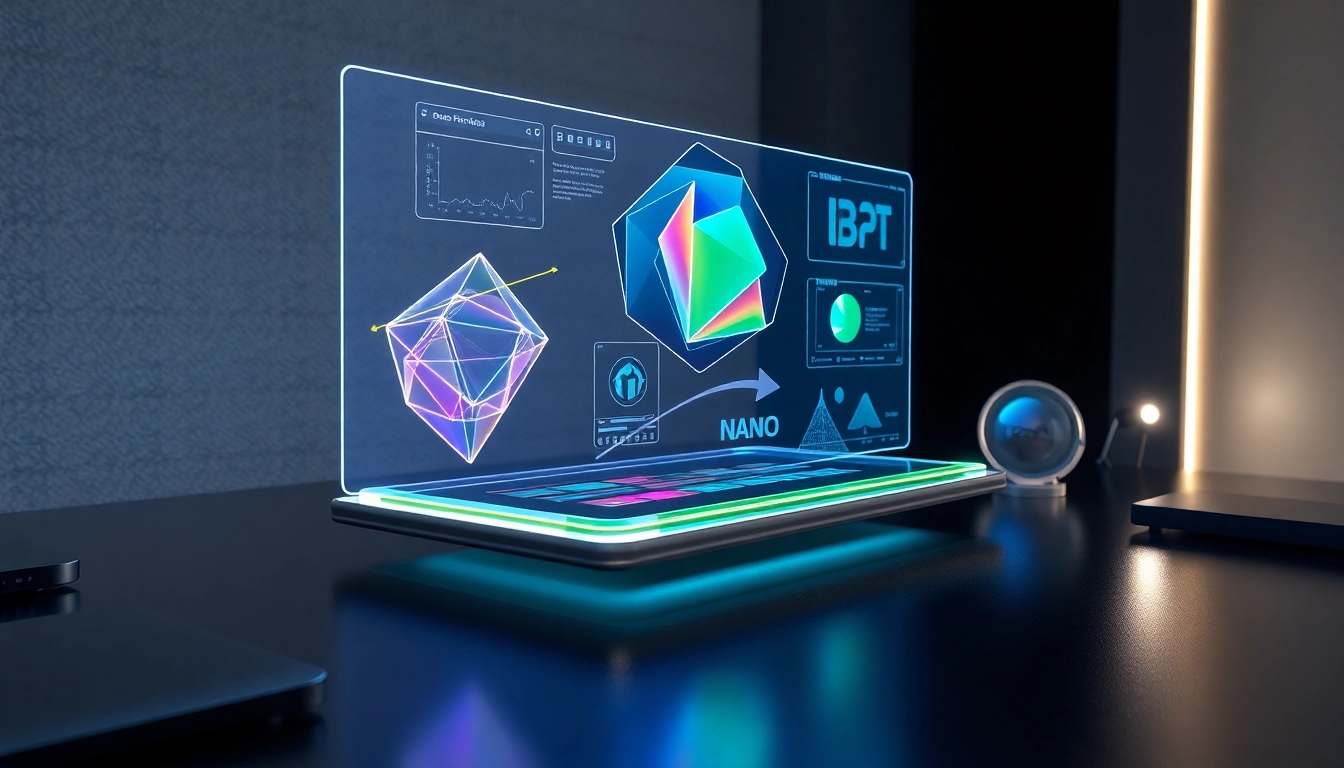Revolutionizing Digital Creativity: The Groundbreaking Impact of Nano Banana AI
In the rapidly evolving landscape of artificial intelligence and digital artistry, few innovations have generated as much buzz as ai nano banana. Promoted as Google’s revolutionary AI image editor, Nano Banana AI stands apart from traditional tools by claiming to outperform all competitors through its unparalleled “advanced reasoning capabilities.” This platform is not just another photo editing software; it represents a paradigm shift in how AI comprehends and manipulates visual content. As creative professionals, marketers, and enterprises seek smarter, more intuitive tools, Nano Banana AI promises to deliver a level of contextual understanding and logical reasoning that redefine the boundaries of digital imagination.
The Technology Powering Nano Banana AI: Deep Reasoning and Spatial Awareness
Advanced Reasoning Capabilities
At the core of Nano Banana AI lies an innovative architecture designed to emulate human-like understanding of images. Unlike conventional AI models that primarily generate or modify images based on superficial prompts, Nano Banana integrates deep reasoning algorithms that interpret the intent behind each request. Whether it’s adjusting lighting, altering perspectives, or seamlessly integrating objects, the AI’s ability to “think” about the image ensures edits are contextually appropriate and visually coherent.
This reasoning prowess stems from sophisticated neural networks trained on vast datasets encompassing diverse visual and textual contexts. As a result, Nano Banana AI can accurately infer nuanced user intentions, such as emphasizing specific elements, maintaining style consistency, or preserving spatial relationships—all critical for professional-grade editing.
3D Spatial Awareness
Another hallmark of Nano Banana AI is its three-dimensional spatial understanding. Traditional image editors often struggle with maintaining perspective and depth, especially when performing complex transformations or object insertions. Nano Banana’s 3D spatial awareness enables it to interpret the depth and spatial relationships within an image, allowing for realistic edits that respect the original perspective.
This feature is particularly valuable for tasks like object removal, background replacement, or adding new elements that blend naturally into the scene. For instance, if a user requests to place a new car in a street scene, Nano Banana AI understands the depth cues and adjusts lighting, shadows, and positioning accordingly, resulting in a seamless integration that would challenge even skilled human editors.
Logical Reasoning and Contextual Comprehension
Beyond visual perception, Nano Banana AI incorporates logical reasoning to grasp the underlying context of images. It can interpret complex prompts, such as “make this scene look like sunset” or “highlight the main subject without losing background details,” and execute these with high accuracy. This capacity stems from its ability to analyze multiple layers of information simultaneously, considering not only the immediate visual elements but also their relationships and narrative significance.
This deep understanding translates into consistent outputs across multiple edits, ensuring that projects maintain coherence and stylistic integrity—even when performing iterative modifications. The platform’s approach aligns with the broader goal of creating AI that doesn’t just mimic human creativity but genuinely understands it.
Comparative Analysis: Nano Banana versus Traditional Tools and Competitors
Limitations of Basic Image Manipulation Tools
Most traditional image editors like Photoshop or GIMP rely heavily on manual input, requiring users to possess significant skill to achieve precise results. Even AI-powered tools such as Flux Kontext or Gemini 2.0 Flash tend to offer basic functionalities—such as straightforward object removal, color adjustments, or simple overlays—without deep contextual understanding.
While these tools are useful for quick edits, they often produce inconsistent results when dealing with complex scenes or nuanced requests. They lack the ability to interpret user intent beyond surface-level commands, leading to a trial-and-error process that can be time-consuming and frustrating.
How Nano Banana Outperforms Competitors
Nano Banana AI distinguishes itself by combining deep contextual comprehension with perfect consistency. According to performance metrics cited by the platform, Nano Banana achieves an estimated 95-99% accuracy in executing user requests, compared to competitors’ 20-70%. This dramatic improvement is attributable to its advanced reasoning algorithms and 3D spatial awareness.
For example, in tasks such as realistic object insertion, scene reconstruction, or style transfer, Nano Banana consistently produces results that align precisely with user expectations. Its ability to understand complex prompts and maintain coherence across multiple edits makes it a preferred choice for professionals demanding high fidelity and efficiency.
Enhancing Creative Workflows with Deep Understanding
From Casual Creators to Professional Artists
Nano Banana AI caters to a broad spectrum of users, from casual social media enthusiasts to professional graphic designers and advertising agencies. Its intuitive interface and powerful capabilities democratize access to advanced image editing, allowing users with limited technical skills to produce high-quality visuals effortlessly.
Casual users benefit from quick edits—like removing unwanted objects or changing backgrounds—while professionals leverage the platform’s deep reasoning to automate complex tasks, such as creating variations, generating realistic composites, or refining visual narratives. This versatility accelerates workflows, reduces reliance on multiple software tools, and minimizes the learning curve.
Streamlining Complex Projects
For large-scale productions, Nano Banana’s logical reasoning enables collaborative workflows where team members can specify detailed requirements, knowing the AI will interpret and execute them accurately. Its capacity to maintain style consistency across multiple images simplifies branding efforts and ensures uniformity in campaigns.
Furthermore, its 3D spatial awareness allows for precise adjustments that would traditionally require meticulous manual effort, saving time and resources. For instance, architectural visualizations or product mockups benefit from realistic perspective corrections and object placements, enhancing the overall quality and realism.
Pricing Structures and Target Audience Segments
Flexible Plans for Different Users
Nano Banana AI offers a tiered subscription model designed to accommodate diverse needs:
– Basic Plan : Ideal for casual creators and hobbyists. Offers essential editing features, limited daily usage, and access to core AI functionalities.
– Pro Plan : Geared toward professionals and small studios. Provides unlimited edits, priority processing, advanced tools, and enhanced customization options.
– Enterprise Solutions: Custom pricing for large organizations requiring API access, integration support, and dedicated service agreements.
This flexible pricing strategy ensures accessibility for individual users while providing scalable solutions for enterprises seeking to embed Nano Banana AI into their creative pipelines.
Value Proposition and ROI
Given its claimed 95-99% accuracy and ability to automate complex editing tasks, Nano Banana AI justifies its premium pricing. By reducing editing time from hours to minutes and minimizing the need for manual retouching, it significantly enhances productivity. For businesses, this translates into faster project turnaround, cost savings, and higher creative quality—making it a worthwhile investment.
Moreover, its capacity to perform high-quality, consistent edits across large volumes of images makes it an invaluable asset for marketing campaigns, e-commerce platforms, and content creators aiming for a competitive edge.
The Future of Visual Creativity with Nano Banana AI
Innovations on the Horizon
Nano Banana AI is poised to lead the next generation of AI-driven creative tools. Future developments may include real-time editing capabilities, even more sophisticated 3D scene understanding, and deeper integration with other creative platforms such as 3D modeling and video editing.
Advancements in natural language processing will likely enable users to describe complex visual concepts more intuitively, further bridging the gap between human imagination and AI execution. Additionally, enhanced learning algorithms could allow Nano Banana to adapt to individual stylistic preferences, offering personalized creative suggestions.
Impact on the Creative Industry
As Nano Banana AI continues to evolve, it promises to redefine standards in digital art, advertising, entertainment, and beyond. Its ability to think about images like humans—understanding context, maintaining consistency, and reasoning through complex tasks—will empower creators to push artistic boundaries previously unattainable with conventional tools.
This technology also raises important questions about the future of digital originality, intellectual property, and ethical use—discussions that must accompany rapid technological advancements. Nonetheless, Nano Banana’s approach exemplifies how AI can serve as a partner in human creativity rather than merely a tool.
Ethical Considerations and Responsible AI Use
Ensuring Fair and Ethical Use
While Nano Banana AI offers remarkable capabilities, responsible usage is paramount. The platform’s deep reasoning abilities could be misused for creating misleading images or deepfakes. Developers and users must adhere to ethical standards, ensuring that AI-generated content is transparent and does not infringe on rights or deceive audiences.
Transparent disclosure of AI involvement in content creation will become increasingly important as such tools become mainstream. Additionally, safeguards, such as watermarks or metadata tagging, can help maintain integrity and trustworthiness in digital media.
Balancing Innovation and Responsibility
Nano Banana’s emphasis on creating an AI that “thinks” like humans underscores the importance of aligning technological progress with societal values. Encouraging open dialogues about AI ethics and establishing industry standards will foster innovation that benefits all stakeholders while minimizing potential harms.
As the platform advances, incorporating features that detect and prevent misuse will be critical to maintaining responsible AI deployment.
Looking Ahead: What the Future Holds for Nano Banana AI
Upcoming Features and Enhancements
Nano Banana AI’s development roadmap hints at exciting features such as:
– Real-time collaborative editing, enabling multiple users to work simultaneously on projects.
– Enhanced semantic understanding, allowing for more abstract and artistic prompts.
– Integration with 3D modeling and animation software, creating a unified ecosystem for multimedia creation.
– Personalized AI models, tailored to individual stylistic preferences and workflows.
These innovations will further solidify Nano Banana’s position as a leader in AI-powered creative tools, fostering a new era of digital artistry.
Potential Challenges and Considerations
Despite its promising trajectory, Nano Banana AI faces challenges including:
– Ensuring data privacy and security, especially with enterprise integrations.
– Managing the ethical implications of highly realistic image synthesis.
– Addressing accessibility and affordability to democratize advanced AI tools.
– Navigating the evolving regulatory landscape surrounding AI-generated content.
Proactively addressing these issues will be essential for sustainable growth and widespread adoption.
Conclusion: The Paradigm Shift in AI Image Editing
In summary, Nano Banana AI is not just another image editing platform; it is a revolutionary force that combines deep reasoning, contextual understanding, and spatial awareness to elevate digital creativity. Its ability to “think” about images the way humans do—understanding intent, maintaining consistency, and executing complex edits—sets it apart from traditional tools and emerging competitors alike. As it continues to evolve, Nano Banana AI will undoubtedly shape the future of visual content creation, empowering creators to realize their visions with unprecedented efficiency and fidelity.
For those eager to experience this leap forward, exploring the nano banana model offers a glimpse into the future of AI-powered image editing—where machines don’t just generate images but understand and create with human-like intelligence. This is more than a technological innovation; it is a cultural transformation in how we conceive, craft, and interact with visual media.








